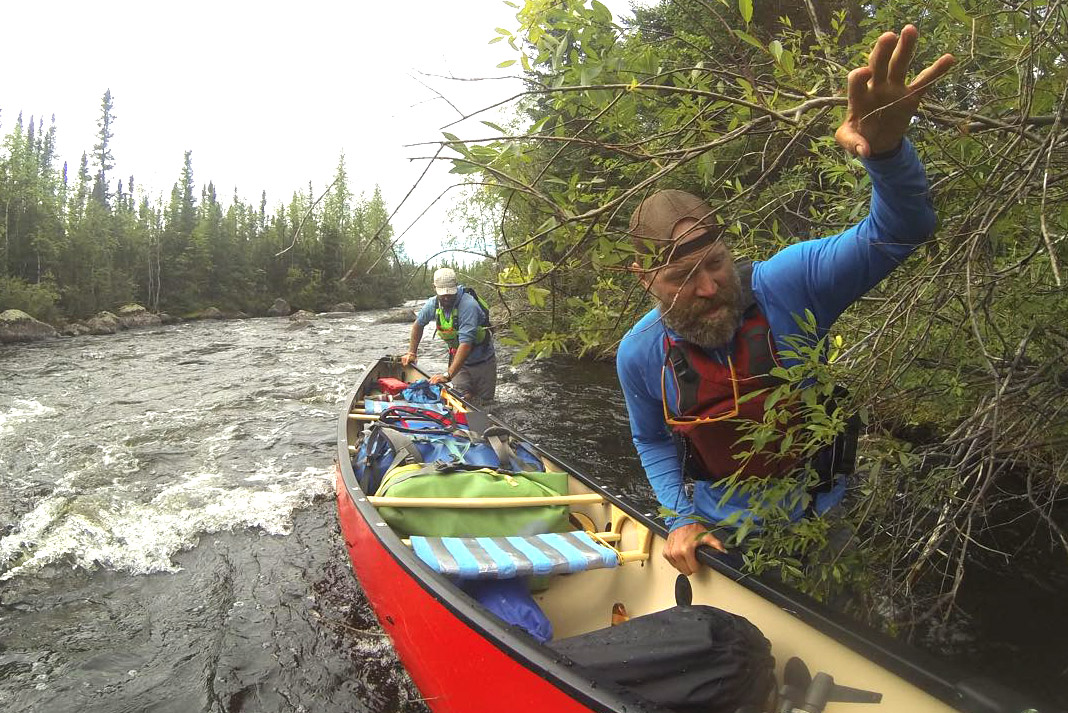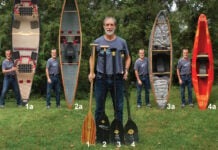Feature Photo: Francois Leger-Savard
While there are a few masochists who love a long portage, for many folks portaging is a means for getting to the next lake, rather than a treasured pastime in itself.
Even the lightest boats are heavy when carried far enough, and I’m guaranteed to be swarmed by bugs the second the canoe is on my shoulders. With sweat dripping down into my eyes and a blackfly at my ear, I’ve certainly found myself thinking, “There’s got to be a better way.”
Well, there isn’t. Not really. But these four experts weigh in on how to help lessen the pain.
1. Manage Your Gear
Becky Mason, Instructor And Guide

Before you get to the takeout, store or tie in all your loose items, keeping water bottles packed but accessible. When you land, pile all of your gear and canoe in one place, well off the trail to leave room for others. Help each other load up.
Done the same way every time this becomes a system—a routine of who carries what and who does the critical final sweep at both ends of the trail. Ask anyone who has spent a lot of time on longer trips and they’ll have a sad story of the person who realized they forgot something three portages back. Trust me, you don’t want to be that person.
2. Conquer Distance
Frank Wolf, Explorer

My strategy is to keep it moving. Don’t stop, just get to the end as efficiently as possible. I trot with the canoe and don’t stop on portages less than three kilometers. There’s always going to be some pain, so get it over with instead of prolonging it.
In the Arctic barren grounds, I will clip the bowline to my PFD tow belt and drag the unloaded canoe over the open terrain. A plastic hull slides easily over heather, low bushes and rock, and takes all the weight off my back and shoulders.
3. Carry The Weight
Lyn Elliott, Parks Canada Officer

You need to find the sweet spot. It’s a mystical place the voyageurs talked about where the weight of your load propels you forward and your feet just have to keep up. I didn’t know it really existed until I was carrying a 70-pound barrel with 14 days of food.
I had been taking it in 500-meter to one-kilometer stints, and then I leaned forward and found the sweet spot. I took the barrel 10 kilometers to Northern Saskatchewan’s Rendezvous Lake in one go.
4. Relieve Aching Shoulders
Cliff Jacobson, Author And Guide

If you want a painless portaging experience, best get an ultralight canoe. Failing that, fit your yoke with thick pads. Drop one arm occasionally as you portage—this transfers the weight of the canoe to the other shoulder, and feels a bit like a break.
If you tire during a portage, don’t set your canoe on the ground. Instead, rest the bow on a horizontal tree limb, stern touching the ground. After you’ve rested you can just walk under the yoke and go again.
Watch here for more tips on how to portage:
This article was first published in Issue 54 of Paddling Magazine. Subscribe to Paddling Magazine’s print and digital editions, or browse the archives.
“Girl, you gotta carry that weight, carry that weight a long time” – The Beatles, and your trip guide | Feature Photo: Francois Leger-Savard









My wife Shirley, carries a light 8 ft pole on long carries or with heavy canoes and we let it support the bow in place of a needed but scarce tree limb when I have
to rest a minute from the canoe. Also the paddles with dollar store knee guards on the blades tied on the thwarts replace a yoke when I carry. Like the article said don’t put the canoe down. Like your articles. Dave Banks
Great tips but can’t help but wonder why no one ever talks about portaging with a tump. Is it a lost art? Yokes, paddles, bare thwart and padded barrel straps are techniques reminiscent of medieval torture devices when compared to a well adjusted tumpline. The tump deserves an article in Rapid. By the way, thanks Scott. I’ll be trying your dingle ropes on my next trip.
The number one standout tip for me was when I adapted an old frame pack so I could rest the yolk on the pack and transfer the weight to my hips. No shoulder pain whatsoever and I carried an 80 lb canoe for 5 miles from the drop off to the put in.
I seldom paddle maintained portages. Often what was once the portages need cutting to get through. Since it can take considerable time to get through, I have adopted relay style portaging. Carry a pack and cut my way for a few hundred metres, walk back for canoe and throw cut stuff out of trail, then carry canoe up cleared trail. This gives me frequent rests and keeps my gear from being strung out over kilometres of trail. Numerous times this has saved our bacon when the first aid kit, bug net, rain gear, water etc is needed. It also keeps us fresh and gives frequent breaks in the work load. I am sure one trip portages are great on decent trails but for re-exploring almost gone old canoe routes they don’t work very well.
One item, that I don’t see, for many canoe trips, is a 10 lb onion bag, and ??100 ft?? of ‘cord’. I have used it, for cold ‘rye o tang’ in the morning – or evening(1 bottle per canoe, on a group trip) or water – leave ,over night, as deep as possible, if you are in a deep lake. A rock, can be a good anchor, for still fishing.
I always take an onion bag, on my trips!
And the biggest factor: go lightweight! The more stuff you leave at home, the less you have to struggle across the portage. In fact, it turns out that single-carry portaging is much less work than double- or triple, if you can get your weight down that far.
Another idea worth considering: a dingle rope (or two). I use two, both fixed bow and stern. My hands hold the ropes down at my sides instead of above my head, which is far more comfortable. And in windy conditions, I can control the boat with minimal strain.
That’s the best tipp from all. The ones in the article are well known, meanwhile.
Awesome info. I’ll be taking my students to the Hurricane Island Outward Bound School (HIOBS) in Maine and doing a 10-day Northwoods course (June 10-19, 2019). We’ll be expedition canoe paddling Moosehead Lake, white-water canoeing the Kennebek and Penobscot Rivers, portaging using the famous, or “infamous” Northern Forest Canoe Trail and rock climbing & rappelling.
Dave Eichler, D.Ed & WFR
Donegal Experiential Education Program (DEEP)
Donegal High School
1025 Koser Road
Mount Joy, PA 17552
(717) 653-1871